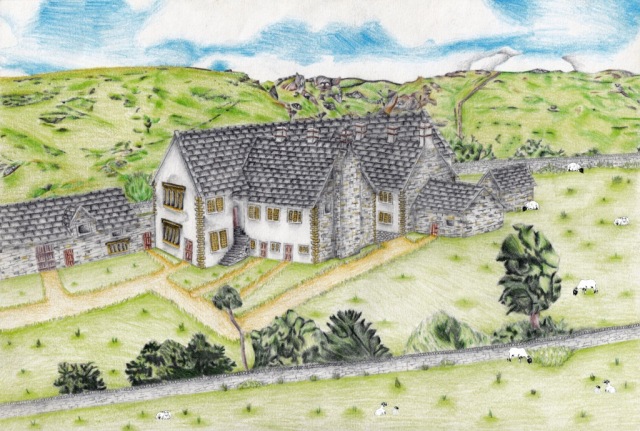The University of Sheffield led two digs this year – one in Castleton at New Hall (behind the Methodist Chapel) and one in Brough near the Roman fort of Navio, both in July/August. In addition, in Castleton a handful of test pits were excavated at the side of Peaks Hole Water near Buxton Road.
As a bonus the dig had it’s own artist this year – see some of her results at the end of the blog post below including a lovely rendition of New Hall.
Navio
The Brough site had visits from a number of groups including children from Castleton and Bradwell Primary schools, and from South Yorkshire and Peak District YACs (Young Archaeologist Clubs). It was ideal for school visits because it was big and there was a lot of Roman pottery to be found – mainly Samian ware and Derbyshire grey ware. Amongst other finds were part of a quern-stone (for milling grain) and large pieces of amphorae (food storage vessels).
Test pits
Linda and Rob’s test pit was notable for its depth…
New Hall
Documentary sources suggest that New Hall was built as a late medieval house, around 1500. For at least 100 years it was home to different members of the Savage family, then in the early 1600s it came under the ownership of the Morewoods. It was sold off in 1825 and by the time of the 1841 census it was divided into three dwellings, home to 25 members of the Beverley, Platt and Wildgoose families. As time went on parts of the buildings fell into decay as can be seen from paintings, etchings and a photograph that survive of the Hall in the 19th century. By 1881 it was uninhabited. From the pictures the house ended up as a building of three wings; front, back and a cross wing. There was also a block of stables or outbuildings running down to Buxton Road.

New Hall c.1864
The old building was demolished around 1890 and a few years later the land was bought by the Wesleyan Methodists for their new chapel which opened in 1898.
This year the focus was on finding the back wing of the house with the thought that it could be the earliest i.e. late medieval part. That idea was largely based on the fact that nothing medieval had been identified in any of the other areas excavated so far and the cross-wing was likely to be a later addition.
The turf, topsoil and demolition layer have to come off before any interesting features emerge.
Whilst the 2019 trench wasn’t huge, the outcome of the excavation was exciting. The trench appears to have reached well into the footprint of the back wing. To the front of it there was an area of stone flags within which a gap was discovered.
At first it was thought there might be a cellar beneath. In the end, once one of the large capping stones was lifted, it turned out to be a well, nicely lined with stone. It was two metres deep down to the sediment and it filled up with water after heavy rainfall (remember Whaley Bridge?).
The fact that the well was capped before New Hall was demolished suggests that its use (as a point for drawing water) ceased at some point during the history of the building. Next year, hopefully, and with sufficient time, it will be possible to investigate it properly.
Stephen and his mini digger made back-filling a doddle again..
Finds cleaning went on throughout the dig with help from Gill and others, especially during wet weather when trench work was rained off.
Thanks
To volunteers including some very hard working students, and to Kay Harrison, David Bostwick and Andrew Bower for valuable insights into New Hall and its history.
Illustrations from Castleton and Brough sites by Rosie Cockrell

New Hall
The illustrations and their interpretation Rosie Cockrell
My illustrations were built on observations of what made up the whole excavation. This included landscapes with rolling hills and buildings, the animals surrounding us and the activities in the trenches. From my experience with archaeologists, I know that as well as the interior of a trench, the humps, slopes and fabric of the hills and valleys tells them about the past. For me, this made the landscapes important to record as well. To demonstrate this importance, I drew them in a precise, colourful way.
Illustrations are made up of narratives. Archaeology is also like storytelling. It suggests to us aspects of people’s everyday life, that can be very different to ours. With this in mind, I made a reconstruction drawing of what the house at the New Hall excavation site might have looked like. I used information from the excavation and old images of the house to do this. It meant I was able to combine the storytelling of archaeology with my own way of representation.
Another aspect of the excavation that I enjoyed was the sense of community. As well as students, a range of people participated in the dig. This included volunteers, professional archaeologists and even school children. Many people already knew each other. I have a personal interest in drawing people, so with many different people doing different things I had an opportunity to study body shapes in a different scenario to what I was used to. I particularly enjoyed drawing a group of archaeologists sitting and talking together in a relaxed way. It emphasised that the excavation wasn’t just a job but a community with genuinely interested people taking part.
